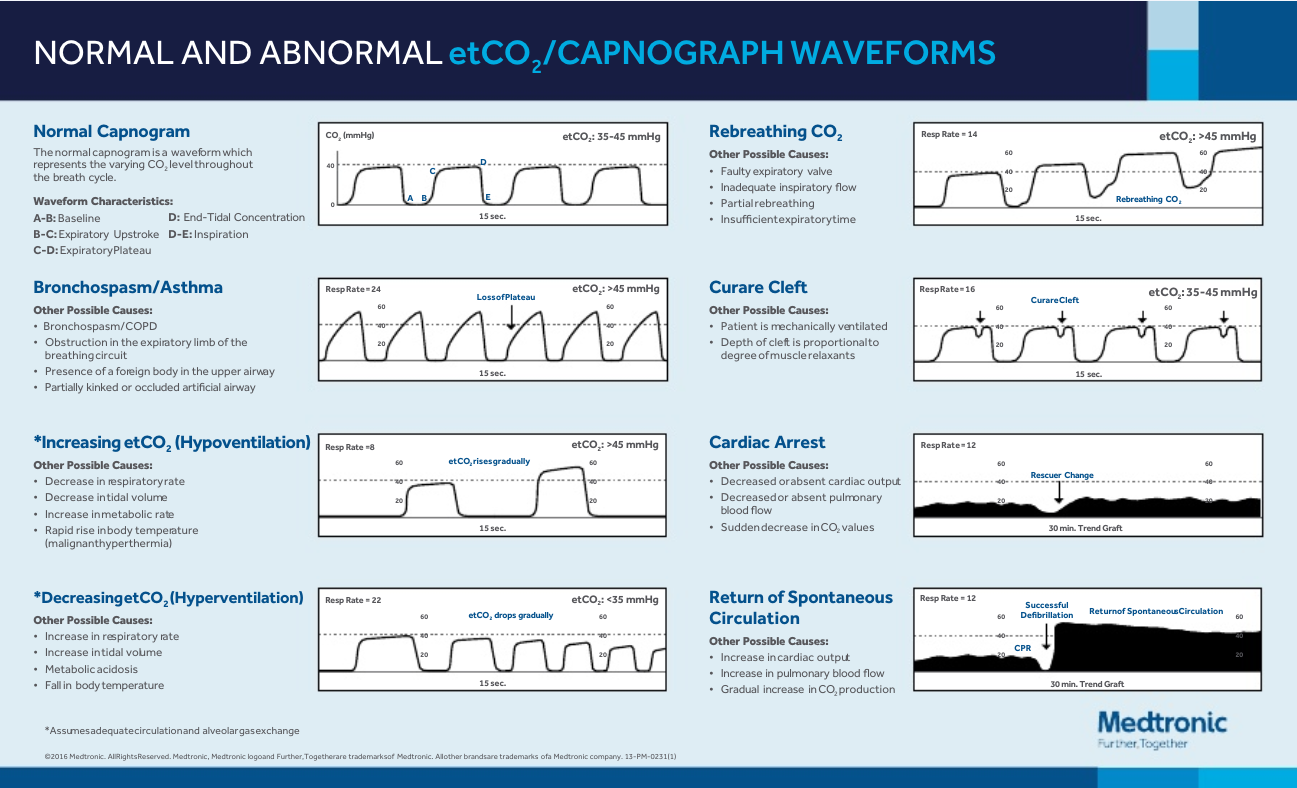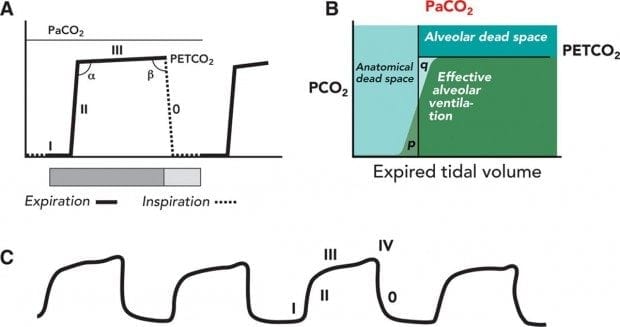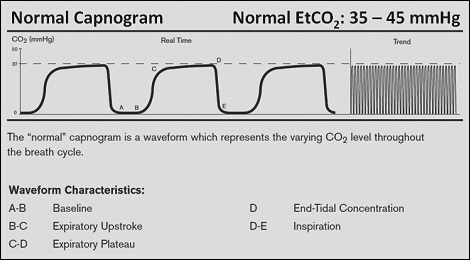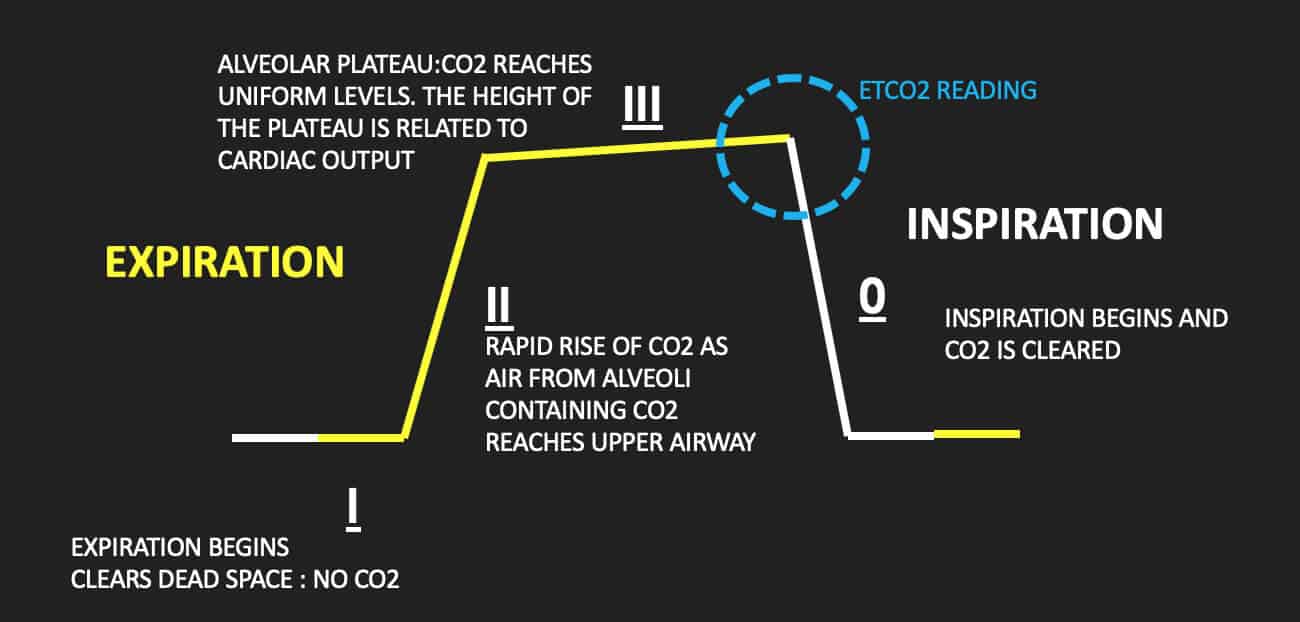normal end tidal co2 levels
1 end-tidal CO2 may be used as a substitute for arterial PaCO2 determinations. It is best to get an ABG along side the end tidal to calculate the patients shunt.
Emdocs Net Emergency Medicine Educationcapnography In The Ed Emdocs Net Emergency Medicine Education
Circulating blood CO 2 is slightly greater than exhaled CO 2 due to a ventilation-perfusion VQ mismatch.

. Capnography can be used to measure end-tidal CO 2. What Is A Normal End-tidal Co2. The normal values are 5 to 6 CO2 which is equivalent to 35-45 mmHg.
2 to near normal normal EtCO 2 35-45 mmHg represents marked increase of CO 2 delivery to lungs suggesting ROSC If patient develops an organized rhythm after VFVTasystole check EtCO 2 to see if ROSC has occurred CONFIRM PLACEMENT OF ETT After intubation if ETCO 2 10mm Hg tube in trachea. According to the book by Hockenberry and Wilson 2015 p 1140 normal values of ETCO2 are 30-43 mmHg which is slightly lower than arterial PaCO2 35-45mmHg. From the alveoli to exhalation the CO 2 is approximately 35-45 mmHg.
What causes low ETCO2. Levels of end-tidal carbon dioxide are low despite normal respiratory rate in individuals with long COVID J Breath Res. The height of the ETCO2 waveform during CPR has been used as an indirect measure of adequate chest compressions helping those involved in resuscitation monitor the effectiveness of their compressions in real time.
Continuous Waveform Capnograpy is written as PETCO2 which stands for patient end-tidal carbon dioxide. The Basic Skills you Need to Succeed. The amount of CO2 at the end of exhalation or end - tidal CO2 ETCO2 is normally 35-45 mm HG.
35-40 mm Hg PETCO2 less than 10 indicates ineffective chest compressions. This phase is also called a descending phase because oxygen fills when inhalation begins and CO2 concentration decreases. Normal end-tidal CO2 values are 35-45 mmHg.
Total pressure of a gas is the sum of the partial pressures of the gas Expired CO2 measured PetCO2 mmHg in waveform Percentage Normal Levels PaO2 85-100mmHg PaCO2 35-45mmHg Percentage vs. Once that has been done you can use an end tidal Co2 monitor as opposed to drawing multiple ABGs. What is end tidal co2 used for.
The creatine kinase was 1200 IUl and the partial thromboplastin time was normal. So the short answer is you are right about the ranges 35-45 but that is for actual PaCo2 drawn from an ABG. 8 Gadgets that will Help you Relax and Unwind.
In patients with normal pulmonary function CO 2 normally 35 to 45 mm Hg and ETco 2 should correlate closely with a deviation of about 2 to 5 mm Hg. 4 At this level it will get exhaled and measured by the EtCO 2 sensor letting. However 3 during hypocapnia the ICBF is reduced an additional 20 when CSFP is elevated.
2 this elevation of CSFP has little effect on ICBF during hypercapnia and normocapnia. In the awake adult normal cardiac index lies between 25-4 Lminm2 with an ETCO2 of 35-45 mmHg. Just so what is the end tidal co2.
In normal conditions CO2 is 5 to 6 which is equivalent to 35-45 mmHg. Normal minute ventilation about 200 mlkgmin for dogs and cats in conscious animals with normal lungs results in an arterial and therefore alveolar CO 2 partial pressure of 35 to 45 mm Hg. The waveform is called capnograph and shows how much CO 2 is present at each phase of the respiratory cycle.
The height of the capnography waveform accompanies this number on the monitor as well as the respiratory rate. As stated before end tidal is slightly different. The normal value is 35-45 mmHg.
The plateau observed at the end of the. What Is A Good Etco2 Level. The number is called capnometry which is the partial pressure of CO 2 detected at the end of exhalation ranging between 35 - 45 mm Hg or 40 57 kPa.
Hence CO 2 levels in the expired gas is a parameter that accurately reflects minute ventilation. Monitoring of end-tidal carbon dioxide EtCO2 is a noninvasive method that measures the partial pressure or maximal concentration of carbon dioxide CO2 at the end of exhaled breath which is expressed as a percentage of CO2. EtCO2 End-tidal CO2 is a noninvasive technique that shows the partial pressure or maximal concentration of CO2 at the end of exhalation.
In conditions of normal breathing 6 Lmin 12 breathsmin 500 ml for tidal volume etCO 2 is very close to alveolar CO2. End-tidal CO2 EtCO2 monitoring is a noninvasive technique which measures the partial pressure or maximal concentration of carbon dioxide CO2 at the end of an exhaled breath which is expressed as a percentage of CO2 or mmHg. The amount of CO2 at the end of exhalation or end-tidal CO2 ETCO2 is normally 35-45 mm HG.
The normal values are 5 to 6 CO2 which is equivalent to 35-45 mmHg. The end-tidal carbon dioxide was 67 mmHg at the time of the blood gas sampling. These values are approximately 14 the normal EtCO2 35-45 mm Hg and ideal CPR will provide at least 14 of cardiac output.
When is end-tidal capnography recommended. Video Game Development. What is a normal end tidal co2 reading.
It was found that. That is ICBF is reduced 50 from normal when end-tidal CO2 is reduced to 2 at this elevated level of CSFP. In severe cases of respiratory distress increased effort to breathe does not effectively eliminate CO2.
Repiratory rate AND depth tidal volume which determine minute ventilation and therefore arterial CO2. Normal value is 35-45 mmHg. End tidal CO 2 EtCO 2 monitoring is the fastest indicator of ventilatory compromise.
The height of the capnography waveform accompanies this number on the monitor as well as the respiratory rate. End-tidal CO2 EtCO2 monitoring is a noninvasive technique which measures the partial pressure or maximal concentration of carbon dioxide CO2 at the end of an exhaled breath which is expressed as a percentage of CO2 or mmHg. ROSC is reflected by a sudden rise in EtCO2.
Capnography waveforms etCO2 and breathing patterns. This is an example of capnography during CPR.

Average Etco2 Kpa During Cpr In Patients With Or Without Rosc Download Scientific Diagram

End Tidal Capnography Can Be Useful For Detecting Diabetic Ketoacidosis Monitoring Copd Acep Now

Normal And Abnormal Capnography Waveforms Infographic Capnoacademy Capnoacademy

Capnography Waveform Interpretation Litfl Ccc Equipment

Waveform Capnography In The Intubated Patient Emcrit Project

Waveform Capnography In The Intubated Patient Emcrit Project

Exhaled Carbon Monoxide End Tidal Co2 And Peripheral Oxygen Saturation Download Table

End Tidal Co2 Monitoring In The Pre Hospital Environment More Than Just Endotracheal Tube Placement Confirmation Journal Of Paramedic Practice

Waveform Capnography In The Intubated Patient Emcrit Project
The Normal Capnograph Waveform Deranged Physiology

Capnogram R Series Defibrillator Zoll Medical Uk

How To Read And Interpret End Tidal Capnography Waveforms Emsuk Learning
Riding The Wave Of Capnography Understanding Etco2 Vetbloom Blog

Exhaled Carbon Monoxide End Tidal Co2 And Peripheral Oxygen Saturation Download Table

Capnography Provides Bigger Physiological Picture To Maximize Patient Care Jems Ems Emergency Medical Services Training Paramedic Emt News

Pdf Applications Of End Tidal Carbon Dioxide Etco2 Monitoring In Emergency Department A Narrative Review Semantic Scholar

The Impact Of Ventilation Rate On End Tidal Carbon Dioxide Level During Manual Cardiopulmonary Resuscitation Resuscitation

